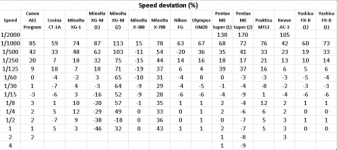I want to ask people experienced with servicing cameras. I've tested shutter speeds on my 15 old SLR cameras using oscilloscope and circuit with fast phototransistor BPW34 (see results on attachment). The common denominator is that most of the cameras have problem with speed 1/500 and almost every camera has problem with speed 1/1000. I've tried to adjust shutter speeds in one Minolta XG-M, which has two potentiometers for adjusting (one for 1/60s and another for 1/1000s). Adjusting speed for 1/60s is very easy. Little turn on potentiometer and speed is adjusted perfectly. But adjusting 1/1000s is impossible. Turning potentiometer has a little impact on speed. Even at the end of the potentiometer range speed is far from ideal.
So, is it possible that shutter rails should be lubricated first on every camera? Or maybe shutter springs become weak after 20-30 years?
I don't think you can reliably test speeds faster than 1/30 with only one (1) phototransistor. On the other hand your test setup is perfect for testing the slow speeds.
On a focal plane shutter, speeds that are above flash-sync-speed (X-speed) up to the top speed are regulated by narrowing the slit opening. Electronic testers for such speed have more than one phototransistor, to be able to test correctly the result. Because you would need to know the curtain travel time AND the opening time.
Also, you need to make sure the slit stays uniform through the travel.
All this criteria is more easily tested using a CRT television, this is explained elsewhere on the net (using a TV as a shutter tester). This is good for the fast speeds AND also allows you to check if the slit opening stays constant !!
As for adjusting the actual fast speeds, as explained above you first need to make sure that the camera is lubricated perfectly. If the camera is perfectly clean and lubricated, chances are that speeds will automatically 'correct' itself. Actual adjustment is performed by varying the slit opening (depends on the camera maker) and/or adjusting the curtain tension -- which I attempted once and is a headache. But then, i don't have a shutter tester.
Otherwise perhaps you can use an Arduino microcontroller and three or four phototransistors and build a fully featured shutter tester!!
Another possibility would be to photograph the actual exposure through the image plane using a DSLR camera. This would tell you if the actual light coming through is OK and will show you any exposure evenness problem!!


